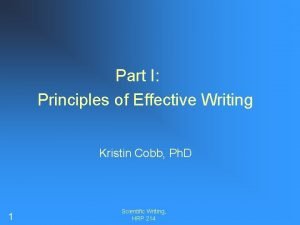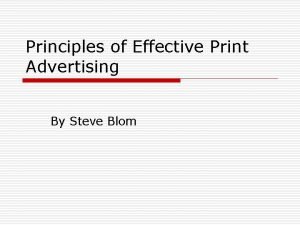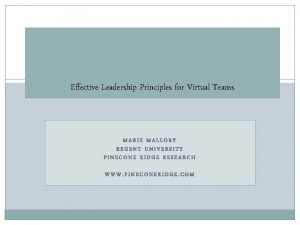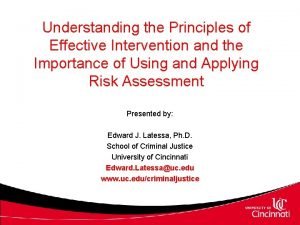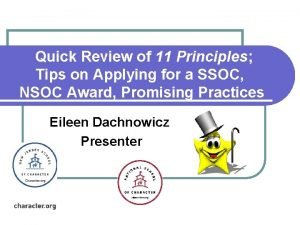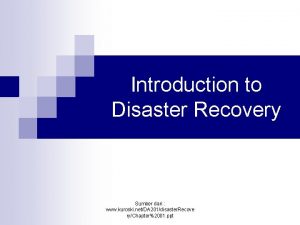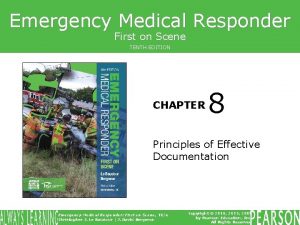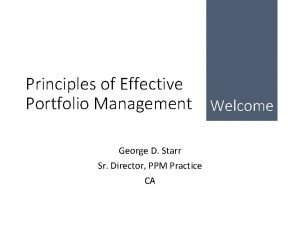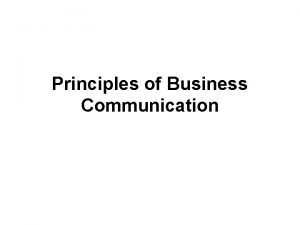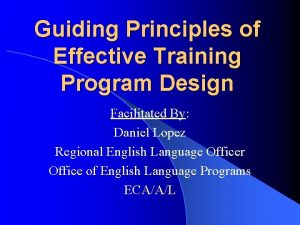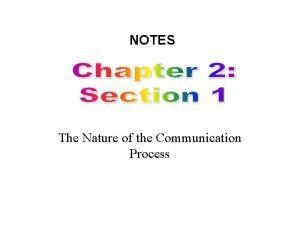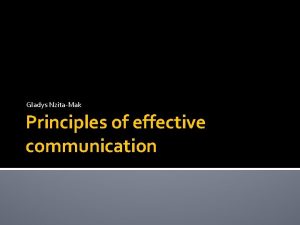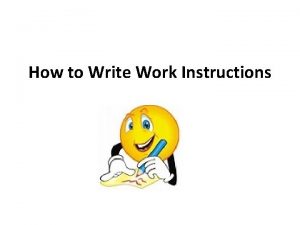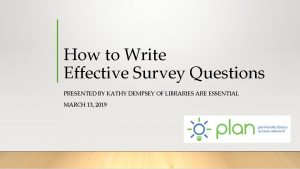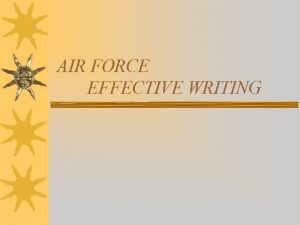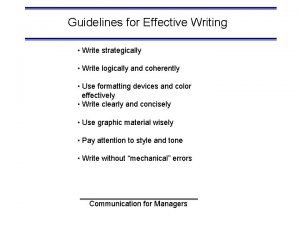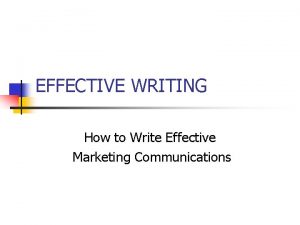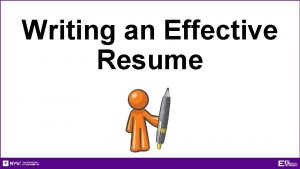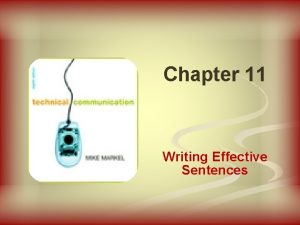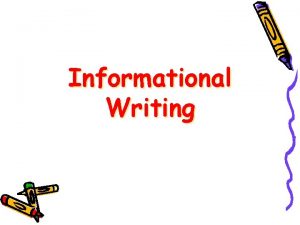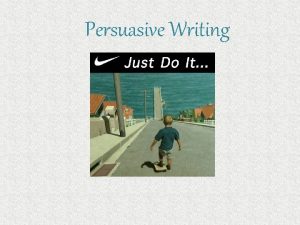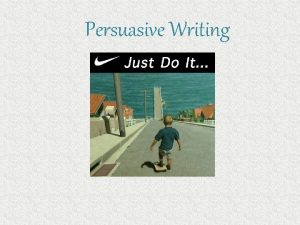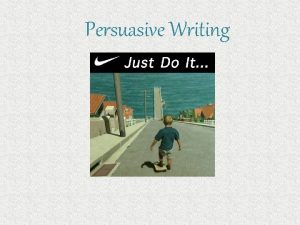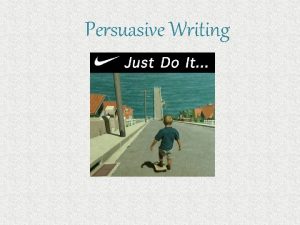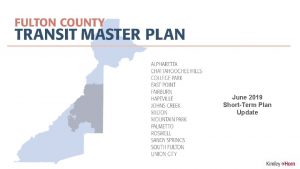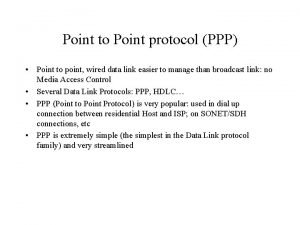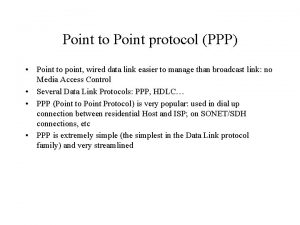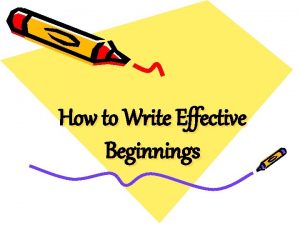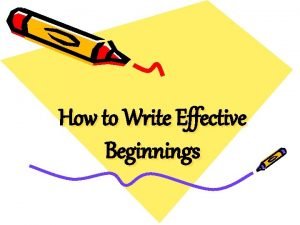Write to the Point Effective Writing Principles for





























- Slides: 29

Write to the Point: Effective Writing Principles for Evaluators Presented by: Joy Quill C. J. Quill & Associates, Inc. EERS 2010 Copyright 2010 C. J. Quill & Associates, Inc.

Principles We Will Cover 1. 2. 3. 4. 5. 6. 7. 8. 9. Know your audience. Organize your material. State the main point first. Write concise sentences. Write effective paragraphs. Use headings effectively. Be consistent. Know when to stop. Review your draft with fresh eyes. Copyright 2010 C. J. Quill & Associates, Inc.

1. Know your audience Varied backgrounds – generally not evaluation experts. Limited knowledge or interest in complex methods. Very busy – want to understand on first reading. Want the main points only. Interested in findings and practical recommendations. If persuaded, may take action. Copyright 2010 C. J. Quill & Associates, Inc.

2. Organize your material Develop an outline. Present material in logical order. Present material in order of importance. Group related information together. Move from general to specific. Answer evaluation questions. Copyright 2010 C. J. Quill & Associates, Inc.

3. State the main point first Conduct research inductively. ◦ Gather facts and data. ◦ Reach conclusion at end of process. Write report deductively. ◦ State main points or findings first. ◦ Easier for reader to follow and understand. ◦ Reader saves time. Copyright 2010 C. J. Quill & Associates, Inc.

4. Write concise sentences 4. 1 Use active voice. 4. 2 Use parallel structure to organize related ideas. 4. 3 Write shorter sentences. 4. 4 Strive for clarity – limit jargon and acronyms. Copyright 2010 C. J. Quill & Associates, Inc.

4. 1. Use active voice Active Voice Passive Voice Subject performs the action. Subject receives the action. One less preposition in sentence. Doer of action is hidden by preposition. Fewer words in sentence. Stronger, more direct language. More words in sentence. Force of writing is weaker. Copyright 2010 C. J. Quill & Associates, Inc.

4. 1 Use passive voice when… The doer is obvious or unimportant. The doer is unknown. The scheduled meeting was cancelled. The project was not completed on time. You wish to emphasize the receiver of the action. Evaluators were trained on effective writing. You wish to diminish the Agreement on the strong tone of active voice. proposed treaty could not be reached. Copyright 2010 C. J. Quill & Associates, Inc.

4. 2 Use parallel structure Parallelism is a way to organize related ideas. It uses structure to emphasize similarity. The similar structure can be words, phrases, or clauses (including sentences). Often uses bullets or numbers to denote parallel items. Copyright 2010 C. J. Quill & Associates, Inc.

4. 2 Parallel Structure Examples Words The evaluator reviewed and verified the preliminary findings. Phrases Opportunity for grant review and program evaluation was lacking. Clauses Although Congressional intent was clear and public acceptance of the program was assured, the agency moved slowly. Bullets, The database administrator’s responsibilities Numbers include: • Creating databases and backups, • Verifying data integrity, • Implementing access controls, and • Ensuring maximum performance and efficiency. Copyright 2010 C. J. Quill & Associates, Inc.

What’s wrong with this sentence? The registry’s major functions are to: facilitate the establishment of a system for finding marrow donors suitably matched to unrelated recipients for bone marrow transplantation; recruit individuals who could be potential donors; and increase the representation of individuals from racial and ethnic groups in order to enable an individual in a minority group, to the extent practicable, to have a change of finding a suitable donor as would an individual not in a minority group. Copyright 2010 C. J. Quill & Associates, Inc.

A possible revision: The registry has three major functions: 1. To establish a system to find unrelated marrow donors; 2. To recruit donors; and 3. To increase donor representation from racial and ethnic groups. Copyright 2010 C. J. Quill & Associates, Inc.

4. 3 Write shorter sentences Limit sentences to 20 -25 words. Limit each sentence to one main idea. Write two shorter sentences instead of one long sentence. Use numbers or bullets to separate parallel phrases. Limit prepositions to 4 per sentence. Eliminate wordy phrases and unnecessary words. Use shorter words. Copyright 2010 C. J. Quill & Associates, Inc.

4. 4. Strive for Clarity – Avoid Jargon Question: What is jargon? Answer: A language of a specialized group generally understood only by group members. Examples: chi square, gigabyte, catchment area Avoid jargon if possible. If using it: Define in footnote. Include glossary. Copyright 2010 C. J. Quill & Associates, Inc.

4. 4. Strive for Clarity – Limit abbreviations & acronyms Use acronyms and abbreviations only when they will help the reader. Unless very common and well known, spell out the first time and follow with acronym in parentheses. Do not use if term appears only once. Spell out again if not used for several pages. Consider simpler term instead of abbreviation. If used in consecutive sentences, use pronoun or simpler term in second sentence. Add abbreviations page. Copyright 2010 C. J. Quill & Associates, Inc.

4. 4. Strive for Clarity – Limit abbreviations & acronyms Original: DMEPOS prices have grown steadily over the past 10 years. Median prices for the 25 most frequently prescribed items of DMEPOS rose by 20 percent between 1995 and 2005. Alternative: Median prices for medical equipment have grown steadily over the past 10 years. Between 1995 and 2005, prices for the 25 most frequently prescribed items rose by 20 percent. Copyright 2010 C. J. Quill & Associates, Inc.

5. Write effective paragraphs Use topic sentences Write unified paragraphs Write coherent paragraphs Write shorter paragraphs Copyright 2010 C. J. Quill & Associates, Inc.

5. 1 Use topic sentences About the topic sentence: First sentence in a deductive paragraph. States the paragraph’s main point. Gives the reader clues on what to expect in the rest of the paragraph. Everything else in the paragraph tells more about the main point. Copyright 2010 C. J. Quill & Associates, Inc.

5. 1 Use Topic Sentences Consists of Subject & Controlling Idea Sentence Subject Controlling idea California uses liens in two specialized ways. California …uses liens in two specialized ways. The degree of employee coverage varies among government agencies that have supplemental regulations. The degree of …varies among employee government agencies coverage that have supplemental regulations. Copyright 2010 C. J. Quill & Associates, Inc.

5. 1 Use topic sentences Cockroaches living in many city apartments and homes are almost impossible to exterminate. What would the reader expect in the rest of the paragraph? Copyright 2010 C. J. Quill & Associates, Inc.

5. 2 Write unified paragraphs About Unity: Every sentence supports, develops or explains the main idea presented in the topic sentence. Several methods can achieve unity: ◦ ◦ ◦ Examples or illustrations Data (facts, statistics, evidence, details) Chronological narration Comparison or contrast Cause and effect Definition or classification Copyright 2010 C. J. Quill & Associates, Inc.

5. 3 Write coherent paragraphs About Coherence: Smooth, logical flow of ideas within a paragraph. Achieve coherence through repetition, parallel structure, and transitions. Transitions are common in technical writing. ◦ Orderly movement from one idea to the next. ◦ Show an idea fits into the discussion. ◦ Only effective in paragraph with basic logical order. Copyright 2010 C. J. Quill & Associates, Inc.

5. 4 Write shorter paragraphs Limit paragraphs to 2 -4 sentences. Cover only ONE MAIN POINT in each paragraph. Use other techniques to convey ideas more clearly. ◦ Bullets or numbers ◦ Active voice ◦ Fewer prepositions ◦ Concise sentences Copyright 2010 C. J. Quill & Associates, Inc.

6. Use headings effectively. Headings tell the story. Headings can capture the reader’s interest. Use statement headings in findings. Some readers will go no further than headings. Copyright 2010 C. J. Quill & Associates, Inc.

7. Be consistent Follow prescribed format. Present information in proper section. Follow consistent writing style. Use terms consistently. Follow grammatical rules consistently. Copyright 2010 C. J. Quill & Associates, Inc.

8. Know when to stop Readers’ time and interest in your subject can vary widely. Consider these levels and write accordingly. ◦ Abstract ◦ Executive Summary ◦ Table of Contents ◦ Short report ◦ Technical appendix Copyright 2010 C. J. Quill & Associates, Inc.

9. Review your draft with fresh eyes Review Techniques: Use a cold reader. Set the draft aside. Read aloud, slowly, one word at a time. Use a cover page. Outline the draft. Look for your usual errors. Copyright 2010 C. J. Quill & Associates, Inc.

10. Review your draft with fresh eyes What to look for: Is it well organized? Is it smooth and logical? Does it make sense? Is your message clear and compelling? Is it clear to a non-technical reader? Does it use mostly shorter words and concise sentences? Does it contain jargon or acronyms? Does each paragraph contain only one main point? Is the tone objective? Are the grammar, punctuation, and spelling correct? Copyright 2010 C. J. Quill & Associates, Inc.

Questions? Joy Quill C. J. Quill & Associates, Inc. 410 -267 -5464 Joy. Quill@aol. com www. quillassociates. com Copyright 2010 C. J. Quill & Associates, Inc.
 Prinsip penulisan surat
Prinsip penulisan surat Principles of effective writing
Principles of effective writing Principles of effective writing
Principles of effective writing Principles of effective teamwork
Principles of effective teamwork Principles of good layout
Principles of good layout Principles of effective practice
Principles of effective practice Principles of effective leadership in virtual teams
Principles of effective leadership in virtual teams Principles of effective intervention
Principles of effective intervention 11 principles of effective character education
11 principles of effective character education Principles of effective planning
Principles of effective planning Color 09152004
Color 09152004 Chapter 8 principles of effective documentation
Chapter 8 principles of effective documentation 10 principles of effective online teaching
10 principles of effective online teaching Basic principles of effective portfolio management
Basic principles of effective portfolio management Principles of communication correctness
Principles of communication correctness Principles of effective training
Principles of effective training 5 principles of effective oral communication
5 principles of effective oral communication Principles of effective communication
Principles of effective communication Principles effective addiction treatment
Principles effective addiction treatment Write work instructions
Write work instructions How to write effective survey questions
How to write effective survey questions Example of paragraph with topic sentence and main idea
Example of paragraph with topic sentence and main idea Fspos vägledning för kontinuitetshantering
Fspos vägledning för kontinuitetshantering Novell typiska drag
Novell typiska drag Tack för att ni lyssnade bild
Tack för att ni lyssnade bild Ekologiskt fotavtryck
Ekologiskt fotavtryck Varför kallas perioden 1918-1939 för mellankrigstiden?
Varför kallas perioden 1918-1939 för mellankrigstiden? En lathund för arbete med kontinuitetshantering
En lathund för arbete med kontinuitetshantering Underlag för särskild löneskatt på pensionskostnader
Underlag för särskild löneskatt på pensionskostnader Personlig tidbok
Personlig tidbok


